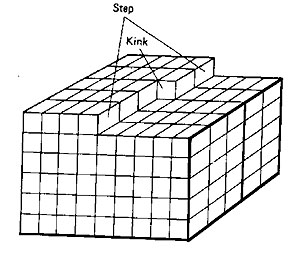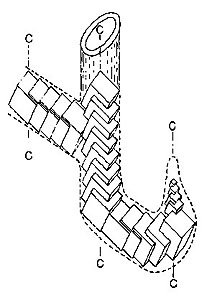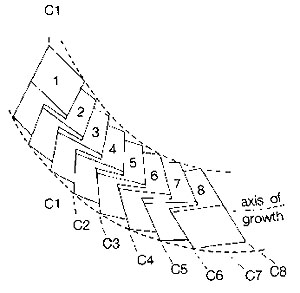As promised in earlier ANDYSEZs we were going to say some more about helictites. Here it is. It probably won't satisfy you at all but short of going into the arcane science (sorcery?) of crystallography in very considerable depth one can't really say much more than we have previously, together with the material below.
Distilling the literature, which I have done diligently on your behalf, indicates that much of what is said about helictites is highly derivative. For example, the ideas of Merrill (1868) and Prinz (1908). Both are cited frequently in others without adequate explanation as you will see. I will endeavour to get the originals for you all so we can see what pearls they had to offer. I must say that producing ANDYSEZs is certainly broadening my education - and hopefully yours!
Lets do some more quoting. W B White (in Ford and Cullingford 1976) has this to say about helictites:
Helictites are smooth-faced stalactitic forms which grow in curved paths, often almost spirals (hence the Greek root of the name) instead of hanging vertically... Moore (1954) showed that most helictites have a central canal and that they grow from the tip...
The helictite form develops when crystal growth forces are dominant over the hydraulic forces of vertically moving water. Specifically, this implies that flow to the helictite must be sufficiently slow to prevent drops forming. Crystallization from the moisture film at the tip then follows the fast growth direction of calcite [remember the c-axis]. Indeed, monocrystalline helictites are found in which the c-axis of the calcite follows the intricate winding path of the helictite. The grains themselves are not curved but are stacked in a twisting pattern, an observation made long ago by Prinz (1908) and confirmed by the petrographic microscope observations of Moore (1954). [What the hell are the grains?]. The origin of the spiral or twisting habitat is not known, although Andrieux (1965) proposed that impurities from overlying soils modified the growth habit. However, Huff's (1940) laboratory-grown helictites had similar curved habits when only pure sodium thiosulphate solutions were used.
The spicular or angulate style of helictites is more obviously controlled by stray clastic impurities which clog the canal, causing growth in a new direction. Likewise, some helictites are known with cores of aragonite which appear to be calcite overgrowths on anthodites (pages 293-94).
Clearly you now have a complete grasp on the issue. I certainly haven't! Let's try again. Quoting this time from Ford and Williams (1989):
To understand reactions at the solid surface it is best to picture a 'step and kink' model such as Figure 1. Atoms and molecules in calcite, etc. are ordered in layers. Atoms at a step have a higher free energy because they expose two 'sides', at a kink three 'sides'. These will be the preferred sites of solution and precipitation. An H+ ion that has diffused to the crystal surface will move across it until encountering a CO32- molecule at such a site. The HCO3- ion created then diffuses away, laying bare a Ca2+ atom which dissociates in its turn.
Most crystals have imperfections. These can be viewed as small fault planes cutting through the regularly stacked boxes of Figure 1 so that there is offsetting extending through all layers. These are 'screw dislocations'. In calcite dissolution, destruction passes from one atomic layer to the next by way of them, much like unraveling successive layers of knitting. In cave calcite precipitation, building of layers with screw dislocations may create the disordered speleothems termed 'helictites' or 'eccentrics' (page 84)

Figure 1. Step and Kink model of atomic structure in a crystal. From Ford and Williams (1989).
Now that we have all of that understood we will look at a couple of individual cases. Figure 2 purports to show what happens when there is prolonged growth of one particular face or direction of a crystal (Bell 1972). An angular helictite results - just what changes the directions appears open to question?

Figure 2. Angular helictite arising from abrupt changes in orientation of the crystal lattice. From Jennings (1985) after Prinz (1908)
Curving helictites are thought to arise from foreign ions causing gradual irregularities in the lattice. Figure 3 shows how these are self-perpetuating and gradually increasing.

Figure 3. Curving helictite arising from gradual changes in the crystal axis orientation. From Jennings (1985) after Prinz(1908)
I hope this has all helped. Although I have not delved very deeply into the mineralogical literature - only consulting the speleological field - it appears to me that the study of helictites is far from complete. Chaos theory would appear to have a great deal to offer here as do disciplines such as X-ray diffraction and so on. There are a couple of dozen PhD theses out there, folks.
Owing to popular demand (well actually, one fairly low-key request) the next ANDYSEZ will be on the subject of phytokarst. This term has at least two, if not three, completely different meanings. The term was first used to describe minor landforms which made walking difficult on the Island of Hell in the Caribbean. All will be revealed...